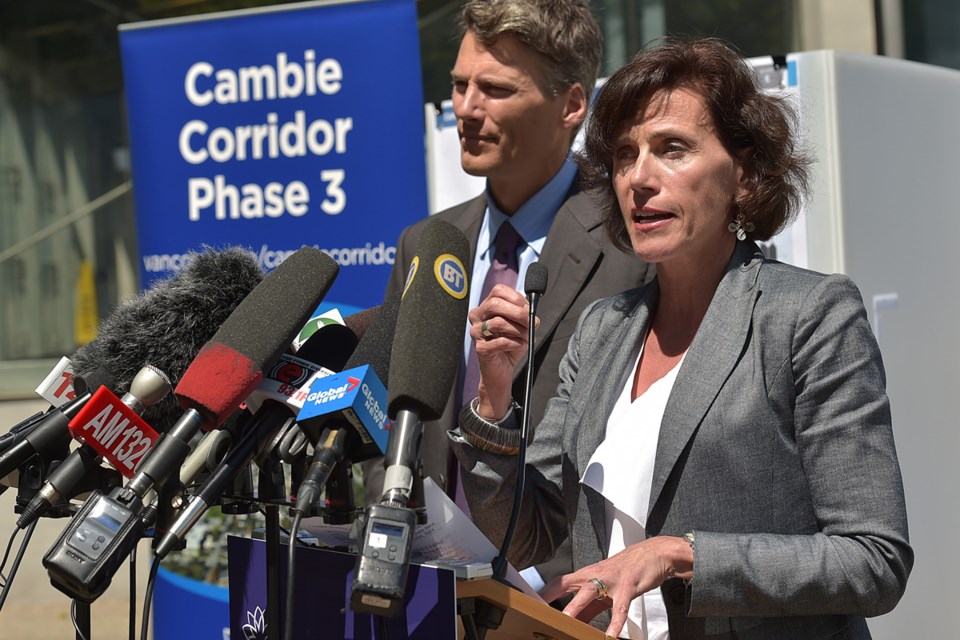The City of Vancouver envisions 11,500 new homes in phase three of its Cambie Corridor plan, with 4,000 earmarked for “affordable” units.
Mayor Gregor Robertson and Susan Haid, the city’s assistant director of planning, outlined details of the draft plan at a press conference outside Oakridge Centre Monday. Open houses are being held on Thursday and Saturday for the public.
The Cambie Corridor planning area covers 16th to the Fraser River between Oak and Ontario streets. The plan addresses growth over the next 25 years.
While phases one and two of the Cambie Corridor plan, which were approved in 2011, focused on sites immediately along the corridor and at cross streets, phase three dips into “shoulder areas,” including some single-family neighbourhoods where the city wants to see alternative housing forms such as duplexes, townhouses and row houses.
“We are looking at a dramatic increase in housing that will be made available here in the Cambie Corridor through phase three in what is now the most aggressive housing push in the city’s history,” Robertson said.
“We have a huge shortage of affordable housing and rental housing in Vancouver and we need to make sure with all these major planning efforts now, like the Cambie Corridor [plan], that we get as much affordable, rental and social housing as we can. And where there are lower density areas, like single-family home neighbourhoods, we start that transition with duplexes and townhouses and row houses to increase the density in a more gentle way.”
Haid said the city heard from more than 3,600 residents during consultation for phase three over the past two years and more than 50 events were held to help shape the draft plan.
During those discussions, lack of affordable housing was a top concern, as was a desire for housing near transit.
“We’re looking at more opportunity for affordable housing, particularly housing that’s geared to the incomes of those that work in Vancouver and our missing middle generation,” Haid said. “A really key goal of the plan is about providing housing for that missing middle — that sort of young adult population, young families [and] millennials, as well as those on lower incomes and our seniors.”
When talking about the missing middle, Haid said it’s necessary to talk about a missing form of housing. While Vancouver has a lot of single-family homes and condos, there’s very little in between.
“We’re providing significant areas that are off the shoulder of Cambie, where we currently have single-family [housing], for ground-oriented housing — this means town housing, row housing,” Haid said, explaining the city has strategies to make townhouses more affordable. “We’re looking at more compact units, things like mortgage helpers and some lock-off units in our town housing forms.”
The city has identified 10 “unique sites” of between two and four acres within Cambie Corridor that it considers "ideal" for affordable housing and rental housing geared to Vancouver residents' incomes. Haid said these sites are also ideal for amenities that are needed to accompany growth such as childcare and senior centres.
Meanwhile, the area around Cambie and 41st is designated as the Oakridge Municipal Town Centre in the Cambie Corridor plan, as well as in the regional growth strategy.
“It’s an ideal location for us to concentrate growth and to create a very robust and liveable town centre in the southern part of Vancouver,” Haid said, while pointing out a number of options for it will be available for feedback at the upcoming open houses.
“As part of that vision [for the town centre] ... our goal number one is about achieving more affordable housing, so again rental units, social housing units, rental units that are geared to the incomes of the workforce, the missing middle and the lower incomes that we see in the city — so really, the real people of Vancouver.”
Other elements of the phase three draft plan include a public realm strategy, a “complete street” along Cambie and a public benefits strategy.
Allan Buium of the Riley Park South Cambie Community Vision Group, which has been monitoring Cambie Corridor plans, wants the city to stop using the term “affordable housing” and start using the term “workforce housing.”
He maintains the word affordable has lost its meaning. And while he plans to attend a phase three open house, he wonders where the affordable housing will go.
He also points to the high cost of homes in development projects that followed the adoption of phase two.
Three projects within the Cambie Corridor area were going before public hearing June 13. Buium said he expects the cost of condos in one of the projects to be not much under $1 million.
“And who can afford that? When you look at the average weekly wage, it’s just not there. The whole Cambie Corridor is like that except probably what they’ll put in at Oakridge — there’s a commitment there,” he said.
Buium added that the city and community groups are in the midst of evaluating phase two of the Cambie Corridor plan.
“Right now it’s in progress, so how can you go into phase three when you haven’t really carefully examined what has transpired in phase two and if you’ve fulfilled your objectives,” he said.
Open houses for Cambie Corridor phase three are scheduled at the Oakridge Centre Auditorium from 4 to 8 p.m., June 15, and from 11 a.m. to 5 p.m., June 17.
Feedback from consultation will be incorporated into a refined plan that will be presented to the public in the fall.
Haid's goal is to bring the final plan to council by the end of the year.
@naoibh
Note: This story has been updated since it was first posted.



